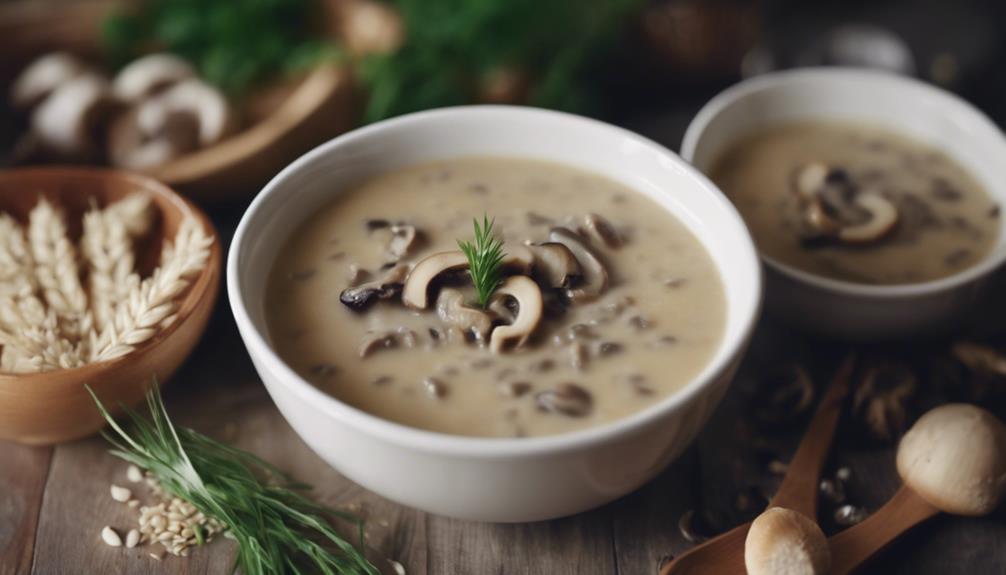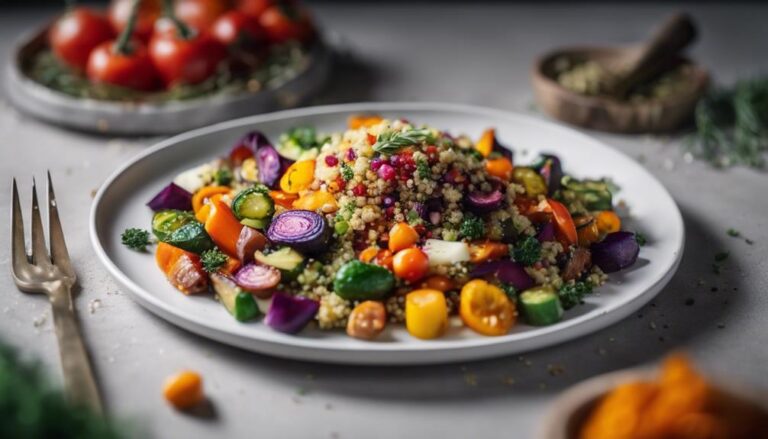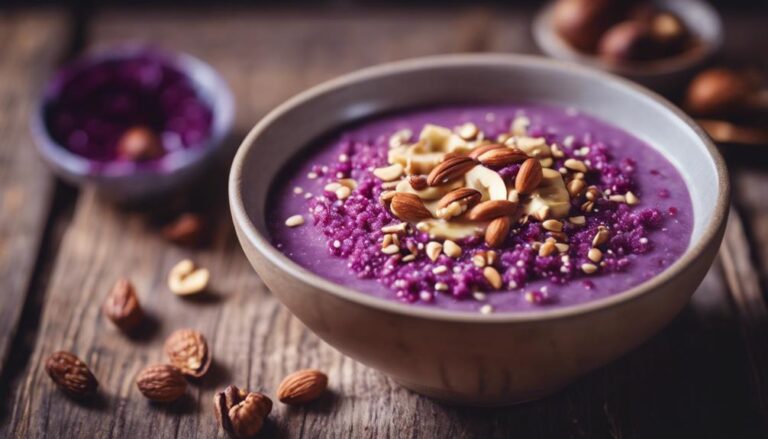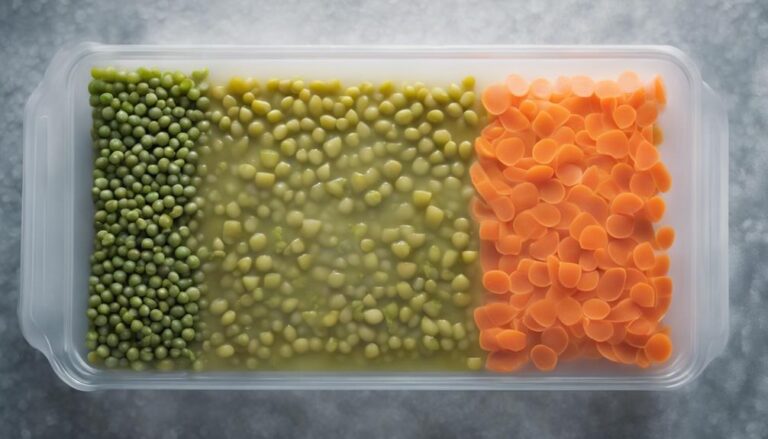Sous Vide Barley and Mushroom Soup
Discover the perfect blend of nutty barley and earthy mushrooms in a velvety sous vide barley and mushroom soup. Elevate your soup game with precise sous vide techniques for impeccable texture and flavors. Mushroom infusion techniques enhance depth and complexity. Explore pairing tips like using soy sauce or mixing mushroom varieties to enhance richness. Finish with sautéed white mushrooms for deep umami essence. This soup, with chicken broth and pearled barley, offers a truly rich and savory experience. Embrace the fusion of flavors waiting to be savored.
What You Will Learn Here
- Sous vide method ensures perfect texture and flavor infusion.
- Use a mix of mushroom varieties for depth and complexity.
- Barley adds chewy texture and nutty flavor to the soup.
- Incorporate umami-rich ingredients like soy sauce for enhanced flavor.
- Slow cooking melds flavors seamlessly for a velvety consistency.
Origin of Barley in Soups
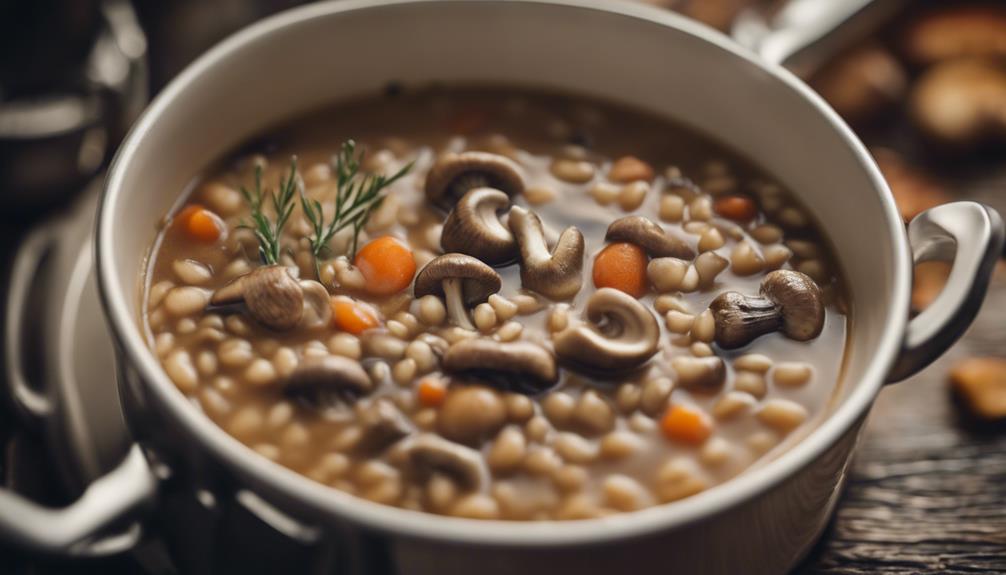
Barley has a rich history in soups, tracing back to ancient civilizations that recognized its culinary value. Its presence in soups not only provides a unique texture and flavor but also offers a range of nutritional benefits.
From its ability to naturally thicken soups to its capacity to absorb surrounding flavors, barley has become a staple ingredient in soups worldwide.
Barleys Soup History
The incorporation of barley into soups can be traced back to ancient civilizations, showcasing its enduring presence in culinary traditions.
Barley, a key ingredient in soups, has a rich history spanning civilizations like the Egyptians and Greeks. Its versatility, hearty texture, and nutritional benefits made it a staple food enjoyed by both peasants and nobility in medieval Europe.
Barley's ability to provide sustenance and energy during lean times contributed to its popularity in soups throughout history. Over time, diverse cultures have added their unique ingredients and flavors, evolving barley soups into a wide array of delicious variations.
This historical journey illustrates the enduring appeal and importance of barley in soup-making traditions.
Barleys Culinary Uses
Exploring the historical evolution of soups reveals how barley's culinary adaptability has played a significant role in shaping diverse soup-making traditions. Barley's nutty flavor and ability to absorb the essence of other ingredients make it a versatile choice for soups. The table below highlights some key aspects of barley's role in soups:
| Culinary Uses of Barley | Description | Examples |
|---|---|---|
| Nutty Flavor | Adds a rich, earthy taste | Barley and Mushroom Soup |
| Texture Enhancement | Provides a hearty consistency | Beef and Barley Stew |
| Flavor Absorption | Enhances overall taste | Chicken Barley Vegetable Soup |
Barley's presence in soups not only elevates the flavor but also contributes essential nutrients, making it a wholesome choice for hearty and nutritious meals.
Barleys Nutritional Benefits
Enhancing soup recipes with a nutrient-rich grain like barley can greatly boost their nutritional profile and add a depth of flavor that complements various ingredients. Barley is a good source of dietary fiber and selenium, making it a valuable addition to soups.
Its history as one of the world's oldest cultivated grains and its inclusion in dishes like Mushroom Barley Soup highlight its significance in culinary traditions. Barley contains beta-glucan, a soluble fiber known to help lower cholesterol levels, contributing to its reputation as a healthy ingredient.
Additionally, barley's presence in the Seven Species mentioned in the Bible symbolizes fertility and abundance, further emphasizing its importance. Including barley in soups not only enhances their taste but also provides essential nutrients for a well-rounded meal.
Mushroom Varieties in Soup
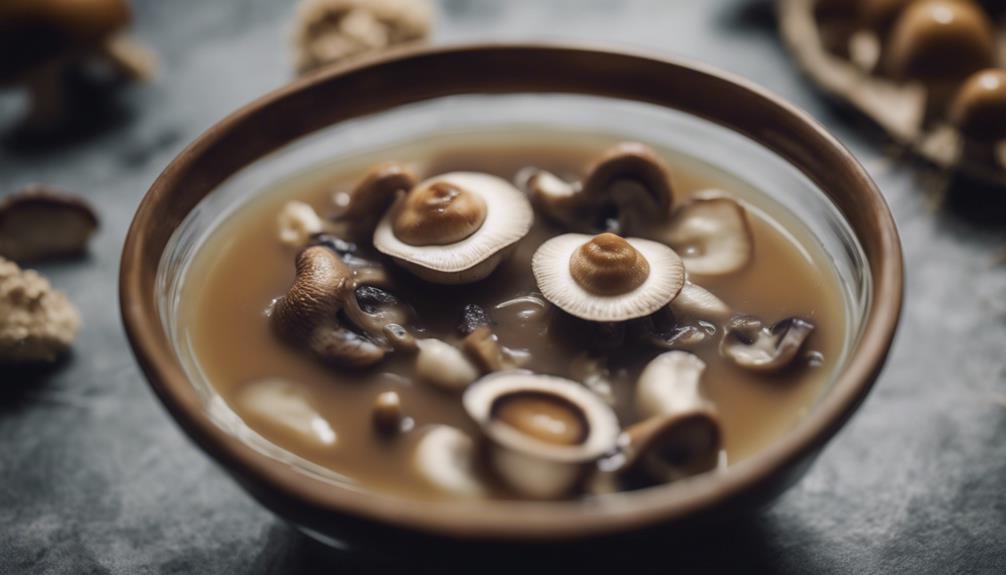
Introducing a diverse array of mushroom varieties can greatly enhance the complexity and depth of your barley and mushroom soup. When selecting mushrooms for your soup, consider the following:
- Shiitake Mushrooms: Known for their rich, savory taste and meaty texture, shiitake mushrooms can elevate the umami profile of your soup, providing a robust and satisfying flavor.
- Oyster Mushrooms: With a delicate and mild flavor, oyster mushrooms complement the earthy notes of barley, resulting in a well-balanced and flavorful combination that appeals to a wide range of palates.
- Wild Mushrooms: Incorporating wild mushrooms into your soup can bring a diverse and complex flavor profile to the dish. Their unique taste adds a more adventurous and wild experience to your culinary creation, enhancing the overall depth and richness of the soup.
Experimenting with different mushroom varieties such as shiitake, oyster, and wild mushrooms allows you to tailor the flavor profile of your barley and mushroom soup, creating a truly customizable and delightful dining experience.
Sous Vide Mushroom Risotto
Sous Vide Mushroom Risotto is a luxurious dish that combines the creaminess of risotto with the earthy notes of wild mushrooms.
The dish is prepared by cooking pearl barley sous vide with a mixture of chicken broth, white wine, and Parmegiano Reggiano cheese.
This technique guarantees a perfect texture and flavor profile that enhances the traditional risotto experience.
Sous Vide Mushroom Risotto
For a sumptuously creamy and flavorful experience, consider trying the Sous Vide Mushroom Risotto. This dish is crafted using the sous vide cooking method to guarantee precise cooking of pearl barley and wild mushrooms in a vacuum-sealed bag.
Here are some key points about this delectable risotto:
- Sous Vide Mushroom Risotto is cooked at a precise temperature in a water bath to preserve the natural flavors and textures of the barley and mushrooms.
- The sous vide technique assures even cooking, resulting in a velvety consistency without the need for constant stirring or the risk of burning.
- This luxurious dish showcases the nutty notes of barley and the earthy essence of mushrooms, creating a harmonious blend of flavors and textures.
Enjoy this gourmet delight that elevates the classic risotto to new heights.
Wild Mushroom Risotto Recipe
Moving from the delightful Sous Vide Mushroom Risotto to the Wild Mushroom Risotto Recipe, you'll begin a culinary journey that celebrates the earthy flavors of wild mushrooms and the creamy richness of risotto.
When preparing this exquisite dish, remember to use pearl barley for its nutty flavor and chewy texture. The cooking time for the risotto may vary but is typically around 18-20 minutes, ensuring the barley is cooked to perfection.
As you bring the soup to a simmer, allow the flavors of the mushrooms and barley to meld together harmoniously. Finally, remember to season with salt to enhance the natural taste of the ingredients.
Barley Osso Buco Recipe
Utilize a combination of tender pork osso buco and flavorful barley risotto, cooked sous vide to perfection, to create a delectable Barley Osso Buco dish.
The recipe features pork osso buco cooked sous vide at 70°C for 24 hours, resulting in a melt-in-your-mouth texture.
The risotto component includes pearl barley, wild mushrooms, Parmegiano Reggiano, and butter, adding a rich and earthy flavor profile to the dish.
To finish, the Osso Buco is seared after sous vide cooking and served with a luscious sauce made with white wine, butter, and parsley.
The barley risotto is prepared by soaking barley, cooking it with chicken broth and wine, then serving it with additional cheese and the succulent Osso Buco.
Enhancing Mushroom Flavor Profile
To enhance the flavor profile of mushrooms, consider incorporating umami-enhancing ingredients, such as soy sauce or miso, during the sous vide cooking process.
Experiment with different mushroom infusion techniques like vacuum-sealing with herbs or garlic to intensify their taste.
Additionally, explore flavor pairing tips to complement the earthy richness of mushrooms, such as using thyme or balsamic vinegar for added depth.
Umami-Enhancing Ingredients
Enhance the robust mushroom flavor profile of your Sous Vide Barley and Mushroom Soup by incorporating umami-enhancing ingredients like soy sauce, miso, and mushrooms.
Soy sauce, rich in glutamic acid, intensifies the umami taste in the soup, enhancing its savory notes.
Miso paste, derived from fermented soybeans, contributes depth and richness to the broth, elevating the overall flavor profile.
Additionally, mushrooms such as shiitake and porcini, being naturally abundant in umami compounds, further enhance the soup's complexity and depth of taste.
Mushroom Infusion Techniques
Infusing mushroom flavor into your soup can be achieved through various techniques, such as rehydrating dried mushrooms or sautéing fresh mushrooms with garlic and herbs. When aiming to enhance the umami-rich profile of your soup, consider using dried mushrooms that have been rehydrated in warm water or incorporating mushroom broth into the base. Sautéing fresh mushrooms with garlic and herbs before adding them to the soup can intensify their flavors. To further elevate the taste, include umami-rich ingredients like soy sauce or miso. Experimenting with a combination of mushrooms such as shiitake, oyster, or porcini can create a more complex and robust mushroom infusion in the soup.
| Technique | Description | Benefits |
|---|---|---|
| Rehydrating | Intensifies mushroom flavor through hydration process | Enhances richness of the soup |
| Sautéing | Enhances mushroom taste by cooking with garlic and herbs | Adds depth and complexity to the soup |
| Incorporating Broth | Infuses soup with concentrated mushroom essence for a more pronounced flavor profile | Provides a robust mushroom base for the soup |
Flavor Pairing Tips
Experimenting with various umami-rich ingredients and mushroom combinations can elevate the flavor profile of your barley and mushroom soup, creating a more complex and robust culinary experience.
Enhance the mushroom flavor by incorporating soy sauce or miso into the soup. Utilize a mix of mushrooms such as shiitake, oyster, or wild mushrooms to add depth. Complement the earthy mushroom taste with herbs like thyme, rosemary, or parsley. Intensify the savory notes by adding garlic, onions, or shallots to the dish.
Try different cooking techniques like roasting or sautéing the mushrooms before including them in the soup to enhance their flavor further. By carefully selecting ingredients and employing various cooking methods, you can create a harmonious and rich mushroom-centric soup.
Final Thoughts
In reflecting on the Sous Vide Barley and Mushroom Soup, consider the harmonious blend of traditional flavors elevated by the innovative cooking technique. The use of chicken broth as a base provides a rich and savory foundation for the soup, enhancing the overall taste profile. The addition of pearled barley adds a delightful chewy texture and a subtle nutty flavor, enriching the dish with its nutritional value and heartiness. White mushrooms, sautéed to perfection at medium heat before sous vide cooking, contribute a deep umami essence that permeates the soup, creating a robust depth of flavor.
The careful infusion of vegetable broth during the sous vide process further enhances the soup's complexity, infusing it with a delicate yet flavorful essence. The slow cooking method of sous vide guarantees that all these elements meld together seamlessly, resulting in a soup that isn't only delicious but also showcases the precision and care put into its preparation. The Sous Vide Barley and Mushroom Soup stands as a confirmation to how modern techniques can elevate classic dishes, offering a gourmet experience that's sure to delight those you serve.
Frequently Asked Questions
Does Barley Help Thicken Soup?
Barley benefits by acting as a natural thickener in soups. Its starches and beta-glucans work wonders, thickening tricks that lend a hearty consistency to your soup. Soup secrets reveal that barley's gelatinous texture and absorption powers enhance the overall texture.
What if I Put Too Much Barley in My Soup?
If you put too much barley in your soup, the texture may become overly thick and absorb too much liquid. Adjust the seasoning and liquid content to balance flavor and consistency while preventing the barley from dominating.
Can You Cook Barley in Broth?
You can cook barley in broth to maximize barley benefits. Broth absorption enhances flavor, nutrient retention, and texture. This cooking technique infuses the grains with rich taste, creating a tender and flavorful dish.
Does Barley Get Mushy in Soup?
Barley texture varies in soup based on cooking time and method. To prevent mushiness, consider adding barley later or cook separately. Explore alternatives like pearled barley for softer texture. Barley's starch content can thicken soup. Flavor with complementary ingredients.
Conclusion
To sum up, incorporating sous vide cooking techniques into barley and mushroom soup enhances the flavors and textures of the ingredients. The precise temperature control allows for a perfectly cooked barley and tender mushrooms, resulting in a rich and flavorful dish.
Experimenting with different mushroom varieties and incorporating them into soups can elevate the overall taste profile and add depth to the dish. Consider trying out a sous vide barley and mushroom soup for a unique culinary experience.
